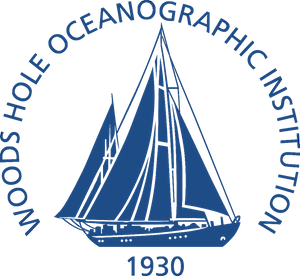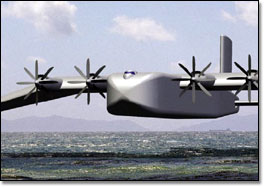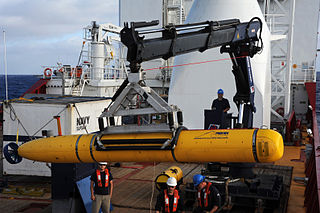Related Research Articles

The Mariana Trench is an oceanic trench located in the western Pacific Ocean, about 200 kilometres (124 mi) east of the Mariana Islands; it is the deepest oceanic trench on Earth. It is crescent-shaped and measures about 2,550 km (1,580 mi) in length and 69 km (43 mi) in width. The maximum known depth is 10,984 ± 25 metres at the southern end of a small slot-shaped valley in its floor known as the Challenger Deep. The deepest point of the trench is more than 2 km (1.2 mi) farther from sea level than the peak of Mount Everest.

The Woods Hole Oceanographic Institution is a private, nonprofit research and higher education facility dedicated to the study of marine science and engineering.

A remotely operated underwater vehicle (ROUV) or remotely operated vehicle (ROV) is a free-swimming submersible craft used to perform underwater observation, inspection and physical tasks such as valve operations, hydraulic functions and other general tasks within the subsea oil and gas industry, military, scientific and other applications. ROVs can also carry tooling packages for undertaking specific tasks such as pull-in and connection of flexible flowlines and umbilicals, and component replacement.

The Boeing X-40 Space Maneuver Vehicle was a test platform for the Boeing X-37 reusable spaceplane, built by Boeing Phantom Works. It sought to test the X-37's systems in order to reduce the cost and risk of future reusable space launch vehicle system.

A diver propulsion vehicle (DPV), also known as an underwater propulsion vehicle, sea scooter, underwater scooter, or swimmer delivery vehicle (SDV) by armed forces, is an item of diving equipment used by scuba divers to increase range underwater. Range is restricted by the amount of breathing gas that can be carried, the rate at which that breathing gas is consumed, and the battery power of the DPV. Time limits imposed on the diver by decompression requirements may also limit safe range in practice. DPVs have recreational, scientific and military applications.

A midget submarine is any submarine under 150 tons, typically operated by a crew of one or two but sometimes up to six or nine, with little or no on-board living accommodation. They normally work with mother ships, from which they are launched and recovered and which provide living accommodation for the crew and support staff.

The Boeing Pelican ULTRA was a proposed ground effect fixed-wing aircraft under study by Boeing Phantom Works in the early 2000s.

An autonomous underwater vehicle (AUV) is a robot that travels underwater without requiring continuous input from an operator. AUVs constitute part of a larger group of undersea systems known as unmanned underwater vehicles, a classification that includes non-autonomous remotely operated underwater vehicles (ROVs) – controlled and powered from the surface by an operator/pilot via an umbilical or using remote control. In military applications an AUV is more often referred to as an unmanned undersea vehicle (UUV). Underwater gliders are a subclass of AUVs.

The Monterey Bay Aquarium Research Institute (MBARI) is a private, non-profit oceanographic research center in Moss Landing, California. MBARI was founded in 1987 by David Packard, and is primarily funded by the David and Lucile Packard Foundation. Christopher Scholin serves as the institute's president and chief executive officer, managing a work force of approximately 220 scientists, engineers, and operations and administrative staff.

Unmanned underwater vehicles (UUV), also known as uncrewed underwater vehicles and underwater drones, are submersible vehicles that can operate underwater without a human occupant. These vehicles may be divided into two categories: remotely operated underwater vehicles (ROUVs) and autonomous underwater vehicles (AUVs). ROUVs are remotely controlled by a human operator. AUVs are automated and operate independently of direct human input.
The Type 925 Dajiang with NATO reporting name Dajiang, or 大江 in Chinese, meaning Great River, is a type of naval auxiliary ship belonging to the People's Republic of China. Each ship is usually equipped with up to two Type 7103 DSRV class Deep Submergence Rescue Vehicles (DSRVs). The ship is designed to replace the first People's Liberation Army Navy (PLAN) submarine tender PLANS Mount Tai, and the lead ship of the Dajiang class is the Changxingdao. The Type 925 is a submarine tender that can also be used as a submarine rescue ship, and hence, it is designated as a submarine support ship by Chinese.
Explorer autonomous underwater vehicle (AUV) is a Chinese AUV developed in the People's Republic of China (PRC), first entering service in November 1994. It should not be confused with another two Anglo-American AUVs that share the same name: the American Autonomous Benthic Explorer AUV (ABE) built by Woods Hole Oceanographic Institution, and the British Columbia-based International Submarine Engineering built Canadian Explorer AUV, which is based on its earlier ARCS AUV. Many Chinese AUVs later developed, such as Wukong, WZODA, CR series, Exploration series, Micro Dragon series, Sea Whale series, Submerged Dragon series AUVs, are all based on experienced gained from Explorer AUV.
AUV - 150 is an unmanned underwater vehicle (UUV) being developed by Central Mechanical Engineering Research Institute (CMERI) scientists in Durgapur in the Indian state of West Bengal. The project is sponsored by the Ministry of Earth Sciences and has technical assistance from IIT-Kharagpur.

The Sentry is an autonomous underwater vehicle (AUV) made by the Woods Hole Oceanographic Institution. Sentry is designed to descend to depths of 6,000 metres (20,000 ft) and to carry a range of devices for taking samples, pictures and readings from the deep sea.
Echo Ranger is a marine autonomous underwater vehicle (AUV) built by Boeing.

The REMUS series are autonomous underwater vehicles (AUVs) made by the Woods Hole Oceanographic Institution and designed by their Oceanographic Systems Lab (OSL). More recently REMUS vehicles have been manufactured by the spinoff company Hydroid Inc, which was a wholly owned subsidiary of Kongsberg Maritime. Hydroid was acquired by Huntington Ingalls Industries (HHI) in March 2020. The series are designed to be low cost, they have shared control software and electronic subsystems and can be operated from a laptop computer. They are used by civilians for seafloor mapping, underwater surveying, and search and recovery as well as by several navies for mine countermeasures missions.

The Bluefin-21 is an autonomous underwater vehicle (AUV) developed by Bluefin Robotics for defence, commercial or scientific use. It found its most famous use in April 2014 in the search for the wreckage of the missing Malaysia Airlines Flight 370.
Echo Voyager is an autonomous underwater vehicle (AUV) built by Boeing.
The Orca is an autonomous underwater vehicle (AUV) that is under development by Boeing and Huntington Ingalls Industries (HII) for the United States Navy.
CSSC unmanned vehicles (UUV)s are uncrewed vehicles developed in the People's Republic of China (PRC) by China State Shipbuilding Corporation (CSSC), most of which are in service with various Chinese governmental agencies/departments, and government-owned enterprises.
References
- 1 2 3 "Boeing's yellow submarine: The new vessel, built in Huntington Beach, can dive down to 20,000 feet". The Orange County Register. 29 July 2015. Retrieved 20 October 2020.
- 1 2 3 4 "Boeing's New Autonomous Sub Can Dive to 20,000 Feet Deep". Wired Magazine. 7 August 2015. Retrieved 20 October 2020.